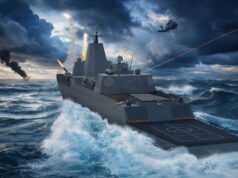Australian firm PMB Defence Engineering has been awarded a contract to improve the main battery module designs onboard British nuclear submarines.
A £22.3m contract has been awarded for ‘Submarine Main Battery TDP Phase 3a – Final Module Design’.
“Submarine Main Battery TDP Phase 3a – Final Module Design is to develop and improve an existing Nickel- Zinc (NiZn) Submarine main battery module design inclusive of initial production standard module build, shock testing and Electromagnetic Interference (EMI) pre-qualification.”
The contract award notice also states:
“Phase 3a is for final module design and there is the option to extend for phase 3b.”
The contract was awarded to PMB Defence Engineering Pty Ltd, an Australian firm.
Some of you might be asking, why would a nuclear submarine need a battery? Well, generally speaking a nuclear-powered submarine will have three sources of electricity (if you count a battery as a source but just assume it is for the purposes of this).
The nuclear reactor produces steam which spins turbine-generators to make electricity. Some of this is stored in the battery after being converted to Direct Current electricity. The submarine also has an emergency diesel generator that can power the battery as well. A battery is essential and can be used to keep the reactor coolant pumps in an emergency.
PMB Defence Engineering state on their website that “our purpose-built production, R&D and Engineering facilities are located at the heart of the naval shipbuilding in Australia”.
The firm has a long history of submarine battery development, their website also states:
“Established in 1989, PMB Defence (PMB) began life with a sole focus on producing the highest quality Main Storage Batteries for the COLLINS Class of submarines. Assisted by our privileged access to Australian stakeholders we have evolved into a leading supplier of high-quality energy and specialised engineering solutions in Australia and select international markets.”
You can find their website here.













“Some of you might be asking, why would a nuclear submarine need a battery?”
I would think the battery (or one of them) would form an essential part of the UPS (Uninterruptible Power Supply) covering all crucial electronic equipment. A UPS is standard in many offices, workshops, hospitals, etc. And certainly critical for a submarine, or skimmer.
Is this part of AUKUS or did we have contracts for Submarine parts from other Countries before that?
AUKUS, I guess – although some components were sourced in France I think.
I suspect this is only the start of the technological co-operation between the 5 eyes that AUKUS is generating – hopefully ending in CANZUK.
Precedes AUKUS I believe. There were rumours flying around back in June as I recall.
Nothing to do with AUKUS. PMB were given a R&D contract from UK MoD some time ago (2019) re Nickel Zinc submarine batteries. While Nickel-Zinc is often considered old tech, new developments has put it up there with Lithium-Ion in some respects but without the problems. Battery tech is a moving target at the moment & PMB is a serious player (customer list includes Australia, Canada, UK & Sweden). They have also recently acquired the submarine battery part of EnerSys.
Surprised they didn’t go with a Japanese company. Especially as they have just started knocking out solid state batteries.
Nickel- Zinc does seem a little out of date. They are the cheapest batteries you can get, even in cars they have been replaced by better tech in higher value models.
Steve
While Nickel-Zinc is old tech, it’s not at the end of the road yet. All battery technologies have problems. The map changes every time a problem is solved. PMB believe they have something in their Nickel-Zinc solution. They also have Pb & Li battery offerings, so they are across the spectrum when it comes to submarines. Either way, submarine batteries are never cheap & are never as simple as they look.
I would have gone with L-ion tech, but it’s v expensive, and on a SSN the battery is only an emergency back up until you either restart the kettle, or get up to PD and snort if it’s going to take a bit longer to kick start the reactor.
Even under a vastly reduced electrical load, the battery doesn’t last long, so it’s always a priority to get the reactor back on line soonest.